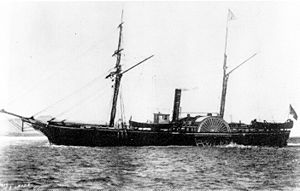 Shubrick
| |
| History | |
|---|---|
| Name | Shubrick |
| Namesake | William Bradford Shubrick |
| Builder | Philadelphia Navy Yard, Pennsylvania, U.S. |
| Cost | $60,000 appropriation; $75,000 (reported) |
| Commissioned | 25 November 1857 (LHS) |
| Decommissioned | 23 August 1861 |
| Recommissioned | 15 October 1861 (RCS) |
| Decommissioned | 24 December 1866 |
| Recommissioned | 24 December 1866 (LHS) |
| Decommissioned | January 1886 |
| Fate | Sold, March 1886 |
| General characteristics [1] | |
| Type | Lighthouse tender |
| Displacement | 305 long tons (310 t) |
| Length | 140 ft 8 in (42.88 m) |
| Beam | 22 ft 6 in (6.86 m) |
| Draft | 9 ft (2.7 m) |
| Propulsion |
|
| Speed |
|
| Armament |
|
USLHT Shubrick was the first lighthouse tender steamer constructed by the Lighthouse Board.[2]
The ship was built at the Philadelphia Navy Yard of "Florida live oak and white oak," left over from the construction of the warship USS Wabash. She was "...topped by a flush deck fore and aft... To better withstand buoys scraping her sides, Shubrick's hull was painted black, topped with a white ribbon and waist. Red paddle wheels, white paddle boxes, and a black bowsprit, yards and gaffs added a saucy touch to her long and graceful cutwater, with six inches of bright copper shining above the waterline."[3]
- ^ "U.S. Coast Guard Cutter History". uscg.mil. Retrieved 9 November 2009.
- ^ "Lighthouse Tenders of the United States". National Park Service. Retrieved 6 January 2008.
- ^ White, Jr., Richard D. (1976). "Saga of the Side-Wheel Steamer Shubrick: Pioneer Lighthouse Tender of the Pacific Coast". American Neptune. XXCVI (1): 47.